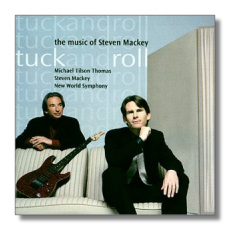
The Internet's Premier Classical Music Source
Related Links
- Latest Reviews
- More Reviews
-
By Composer
-
Collections
DVD & Blu-ray
Books
Concert Reviews
Articles/Interviews
Software
Audio
Search Amazon
Recommended Links
Site News
 CD Review
CD Review
Steven Mackey

Tuck and Roll
- Tuck and Roll
- Lost and Found
- Eating Greens
Steven Mackey, electric guitar
New World Symphony Orchestra/Michael Tilson Thomas
RCA Red Seal 09026-63826-2 DDD 62:11
There's not much that sounds like the music of Steven Mackey, and that's saying something. Mackey's past includes freestyle skiing, early music performance, rock bands, and providing a guitar accompaniment for his brothers' LSD trips circa 1969. (Peace, man.) Is it any wonder that, given what went in his brain, what comes out sounds like this? Imagine a Bugs Bunny cartoon jointly scored by Frank Zappa and Charles Ives, and that will give you some idea of Steve Mackey's unusual gifts.
Tuck and Roll (the title alludes to the leather upholstery once found in American cars, not to fire safety or fat reduction techniques) is a work for electric guitar and orchestra – call it a concerto, if you like, but it strays far from the classical ideal. It is in four sections: "Anthem," "Dark Caprice," "Intrigue," and "Puffe." From the moment it begins, we find ourselves in a world disjointed yet strangely familiar, like the view in a mirror that's been broken. The music plinks along like a drunken gamelan, and random flecks of percussion, which include solitary hand claps, throw the listener even further off kilter. By the time the guitarist enters with a testosterone-laden solo, we're on the edge of our seats, wondering what assault on concert hall propriety Mackey will sling next.
Lost and Found was heard on a Mackey CD released five years ago (Bridge 9065). The Bridge version was scored for four guitars, classical and electric. This new version is described by the composer as "a snappy five-minute toccata and fanfare for orchestra." Nothing gets in the way of the toccata's kaleidoscopic graceful but perhaps over-eager high spirits; no sooner has a color and a texture been established when Mackey replaces it with something new. The brief fanfare that follows is Rube Goldberg music, perhaps a cousin of Paul Klee's twittering machine. It disappears in the distance, presumably to wreak havoc elsewhere.
Eating Greens is an orchestral work in three parts and seven sections. The first part is named for the "domestic themes" of religion (a "(Lethargical) Reformation"), food ("Waffling (sic)"), and art ("Whim and Rigor (Homage to Henri Matisse)"). The middle of these three movements is a phantasmagoric collage of "Here We Come A-Caroling" and party noise-makers, capped by the sound of a phone off its hook and the recorded message, impersonal yet vaguely threatening, of an operator. The second and third parts are named "Loose Ends" (which includes "The Title Is Almost As Long As The Piece Itself," a short but memorably vile inspiration for slack-stringed violin) and "Five Chords." The final movement, named "Drunk Monk," is subtitled "Homage to Thelonius Monk," a jazz pianist Mackey admires for his "quirky, all-thumbs style."
This music doesn't take itself too seriously, and yet it's anything but lightweight. Or, to turn that statement around, Mackey is a kidder with an apparent fondness for scandalizing subscription-holders, yet his music is finely crafted and touchingly sincere. Michael Tilson Thomas is hip enough to understand this, and the young adults of the New World Symphony (a training orchestra based in South Florida) relish Mackey's consistently fascinating weirdness. The production and engineering team of Jay David Saks and Tom Lazarus add to this disc's unqualified success.
Copyright © 2001, Raymond Tuttle


















